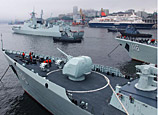
A central axis not only runs through its main buildings but it also lies on the central axis of Beijing, with three main audience halls, three chambers, and the imperial garden all located on the axis. Other palaces are symmetrically distributed on both sides of the halls and chambers on the central axis, all looking magnificent and resplendent. The palace is composed of outer palaces and inner chambers. The outer palaces are centered around three large halls—the Hall of Supreme Harmony, the Hall of Central Harmony, and the Hall of Preserving Harmony, flanked by the Hall of Literary Glory and the Hall of Martial Spirit on either side, while the inner chambers are centered around the Palace of Heavenly Purity, the Palace of Union and Peace, and the Palace of Earthly Tranquility, and flanked by six palaces to the east and the west respectively. The entire design is reasonable and orderly. The four corners of the Imperial Palace have turrets that look beautiful and exquisite. The walls that surround the Imperial Palace are 10 meters high and 3,400 meters around, and outside the walls lies the 52-meter-wide moat.
The most attractive buildings in the Imperial Palace are the Hall of Supreme Harmony, the Hall of Central Harmony, and the Hall of Preserving Harmony. They were all built on 8-meter-high pedestals made of white marble, and look like palaces described in the myths from afar. The first hall, the Hall of Supreme Harmony, is the most magnificent building. It is commonly known as the “Jinluan Palace" (throne room), and was where the emperors held various ceremonies and rituals. The Hall of Supreme Harmony is 28 meters high, 63 meters long from east to west and 35 meters wide from south to north. It has 92 columns with a diameter of one meter each. Among them, six are dragon columns painted with gold lacquer and surround the throne. The throne was set on a two-meter-high platform, with attractive sculptures of cranes, furnaces, and dings (a kind of ancient Chinese sacrificial ware) in the front and fine folding screens in the back. The entire hall is resplendent, magnificent and solemn. The Hall of Central Harmony was the place where the emperor rested before going to the Hall of Supreme Harmony to preside over a grand ceremony and where rituals were rehearsed. The Hall of Preserving Harmony was where the emperor held banquets on New Year’s Eve for his relatives who lived outside the capital city.
At the back of the Imperial Palace were the inner chambers, which were centered on the Palace of Heavenly Purity, the Palace of Union and Peace, and the Palace of Earthly Tranquility, and flanked by six palaces to the east and the west respectively. The inner chambers were where the emperor handled everyday affairs and where the concubines lived. The architectural style of the inner chambers is different from that of the front part of the Imperial Palace. The buildings in the front part are solemn, majestic and magnificent, symbolizing the supremacy of the emperor, while the inner chambers were built for everyday life, and most chambers have their own courtyards, gardens, studies, pavilions, rockeries and ornamental stones. The Imperial Garden is located to the north of the Palace of Earthly Tranquility. In the Imperial Garden, there are towering pines and cypresses, rare flowers and trees, hills and rocks, and pavilions. The Wanchun Pavilion and the Qianqiu Pavilion are the most beautiful among the pavilions in existence.
A large quantity of precious cultural relics has been preserved in the Palace Museum, totaling almost 1.1 million relics according to statistics. It accounts for one-sixth of the total cultural relics in China. Many of them are unique treasures, and museums exhibiting artworks of various dynasties, museums exhibiting treasures, and museums exhibiting clocks were set up in some palaces. Art aficionados often stand for a long time in front of the exhibitions and do not want to leave. In the museum of treasures on the east road of the Imperial Palace, people can see all kinds of priceless artifacts such as a suit of armor from the Qing Dynasty, with a lifelike pattern of 16 dragons that seem to be flying in the clouds. The armor was made of 600,000 small steel pieces, with each piece about one millimeter thick, four millimeters long, and 1.5 millimeters wide. All of these steel pieces have holes made by drills so they could be linked together. It is said that over 40,000 hours were spent making the armor.


















 Teenage crash victims were talented students
Teenage crash victims were talented students


![]()
